
Photo courtesy of Bill Buchanan/USFWS
From nature preserves to your own backyard, late fall and winter are opportune times for birdwatching in Pennsylvania.
You may enjoy peering at birds in Pennsylvania’s skies, trees, and fields when they’re appearing in spring to nest, chirping in summer, or foraging for food in the fall. But did you know that late fall and winter are also opportune times to go birdwatching in Pennsylvania? It’s true that many species that love Pa. migrate south for the winter, but there are plenty of birds hailing from the far north that migrate south to Pa., only visiting us in the snowy season. Plus, you can still spot species that hang around the state all year — as long as you know where to look.
We’ve put together a guide to seven of our favorite spots in Pa. to spot birds in the colder months (think November to March). Many of our destinations feature lakes and rivers — excellent for seeing waterfowl — but others too will have you exploring mountains. And while your best birding opportunities will be in southern Pa., have no fear: You can still see birds farther north. From house sparrows to bald eagles, you have ample reason to break out your binoculars.
Middle Creek Wildlife Management Area – Stevens (Lancaster County)

Photo courtesy of Discover Lancaster
Willow Point at Middle Creek Wildlife Management Area in Lancaster County is famous among bird lovers for a seasonal reason. Each winter, tens of thousands — sometimes hundreds of thousands — of snow geese make a pitstop at Middle Creek as they migrate along the Atlantic Flyway. These large, mostly stark white birds make their nests in the arctic tundra and winter in coastal salt marshes. You can see them at Middle Creek when they fly back north as winter ends. The best viewing location is Willow Point, though it’s often crowded during snow geese season. mid-February to mid-March. It’s best to get to the point early, just before sunrise, which is one of the best times to see the geese before they leave to feed and when there may be fewer visitors. If you can’t make it out to Willow Point, you can always watch the Middle Creek live cam.
John Heinz National Wildlife Refuge at Tinicum – Philadelphia
Located just a short distance from the heart of the city, the John Heinz National Wildlife Refuge at Tinicum is a natural oasis tucked inside the city. During late fall and winter, Tinicum Marsh — the largest freshwater tidal marsh that remains in the state — is home to an abundance of birds, including nesting bald eagles. These birds begin their mating rituals as early as mid-January, which includes beginning to build the nest together (aww). Eaglets hatch in late winter and early spring. You can view the birds, which nest in the tallest tree in the middle of the manmade impoundment, from a wildlife refuge trail. Take the trail from the education center around the west side of the march, where a sign will alert you to the best viewing areas.
Presque Isle State Park – Erie
One ideal place to go birdwatching in the fall and winter happens to be in one of the most northern parts of the state, the shores of Lake Erie. Lakes and waterways are some of the best places for birds in the colder months, and this is especially true for Presque Isle State Park, which can see hundreds of species of birds even in winter. You may even spot rare birds like the snowy owl. During late November and through December, migrating birds, especially waterfowl, fly south across Lake Erie and stop at Presque Isle. (More birds are likely when the lake isn’t frozen). Watch loons, owls, finches, and more on biodiverse Gull Point; a viewing area is accessible via Gull Point Hiking Trail.
Hawk Mountain Sanctuary – Kempton (Berks County)

Photo courtesy of Richard Bonnett
Though named for hawks, you can see a multitude of migrating raptors (birds of prey) at Hawk Mountain Sanctuary in Berks County. You can view birds year-round from the mountain, but fall is the ideal time to see raptors like hawks, eagles, vultures, ospreys, and falcons. Through Dec. 15, take the Lookout Trail to hike to the sanctuary’s North Lookout for views of the migration. You can also check the raptor count on the website to see how many birds have been spotted in recent days. When the migration ends, you can still visit Hawk Mountain and walk the wintery trails, taking care to notice the hardy songbirds making the mountain their home even in the snow.
Nature Trails in the Capital (Wildwood Park and City Island) – Harrisburg

Photo courtesy of Christopher Bley
November is one of the best months to see migrating waterfowl in Pennsylvania, but you may also continue to see birds along rivers as the winter unfolds. One such river is the Susquehanna, which you can access throughout central and eastern Pa. The largest city on the lower Susquehanna is Harrisburg, and its Wildwood Park is a natural area that’s great year-round for birding. It’s also an excellent place to learn about birds: Each month this winter the Appalachian Audubon Society is hosting “Birds and Coffee” at Wildwood’s Nature Center Bird Viewing Area to discuss birds of the area.
City Island, where the Harrisburg Senators play in the warmer months, is also a great place to scout for birds in the colder parts of the year. The island is in the middle of the Susquehanna and offers a great view of the Harrisburg skyline as well as nature trails. Look for ducks and gulls enjoying the peace of a summer destination in the winter.
Powdermill Nature Reserve – Rector (Westmoreland County)
Did you know the longest-running, year-round bird banding program in the country is located just south of Pittsburgh? Powdermill Nature Reserve in Westmoreland County is a research center for Pittsburgh’s Carnegie Museum of Natural History with a program devoted entirely to birds. Researchers use bird banding — a technique in which they put colored bands on birds’ legs to track them — in order to study individual birds. As birds migrate throughout winter and spring, banding allows researchers to learn more about their habits.
But Powdermill isn’t just for scientists. The reserve also hosts community workshops, and its surrounding woods are full of nature trails open to the public. Trails are open from dawn to dusk (except during rifle hunting season), but the reserve’s nature center is only open on Fridays and Saturdays during the colder months. Still, you can join researchers for a December workshop on the Christmas Bird Count. You’ll learn about counting birds to participate in the “community science project” as well as how to best attract birds to your feeders.
Your Backyard
That’s right, you don’t even have to leave home to see birds in Pa. this fall and winter, as long as you put up a feeder. Because natural sources of food for birds during the colder months may be buried under snow or frozen, you can help provide for the birds and attract them to your yard. Birds that you may see in your backyard at feeders include American goldfinches, chickadees, cardinals, juncos, blue jays, and more. Keep a log of the names or characteristics of the birds you see at your feeder so you can learn what birds make your neighborhood their home.
Make sure you choose a good feeder that will protect the feed from the elements. You’ll also want to make sure the feed you select is hearty, and full of proteins and fats to keep birds satisfied.
Politics

How to apply for a job in the American Climate Corps
The Biden administration announced its plans to expand its New Deal-style American Climate Corps (ACC) green jobs training program last week. ...

Gov. Shapiro is bringing period products back to Pennsylvania’s public schools
In his budget proposal, Gov. Josh Shapiro has called for $3 million to be set aside to provide period products to all public school students free of...

Abandoned oil and gas wells are making Pennsylvanians sick. Rep. Summer Lee has a fix
The US House passed Congresswoman Summer Lee’s bipartisan bill to tackle abandoned oil and gas wells. Pennsylvania leads the country in abandoned...
Local News

What do you know about Wawa? 7 fun facts about Pennsylvania’s beloved convenience store
Wawa has 60 years of Pennsylvania roots, and today the commonwealth’s largest private company has more than 1,000 locations along the east coast....

Conjoined twins from Berks County die at age 62
Conjoined twins Lori and George Schappell, who pursued separate careers, interests and relationships during lives that defied medical expectations,...






